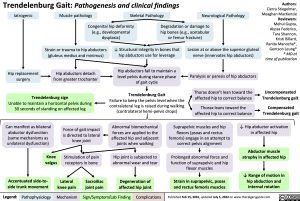Trendelenburg Gait: Pathogenesis and clinical findings
Authors: Cierra Stiegelmar, Meaghan MacKenzie Reviewers: Mehul Gupta, Alyssa Federico, Tara Shannon, Kristi Billard, Ranita Manocha*, Gentson Leung* * MD at time of publication
Uncompensated Trendelenburg gait
Compensated Trendelenburg gait
Iatrogenic
Muscle pathology Skeletal Pathology Neurological Pathology
Congenital hip deformity (e.g., developmental dysplasia)
Degradation or damage to hip bones (e.g., acetabular or femur fracture)
Hip replacement surgery
Strain or trauma to hip abductors (gluteus medius and minimus)
Hip abductors detach from greater trochanter
↓ Structural integrity in bones that hip abductors use for leverage
Hip abductors fail to maintain a level pelvis during stance phase of gait cycle
Trendelenburg Gait
Failure to keep the pelvis level when the contralateral leg is raised during walking (contralateral hemi-pelvis drops)
Lesion at or above the superior gluteal nerve (innervates hip abductors)
Paralysis or paresis of hip abductors
Thorax doesn’t lean toward the affected hip to correct balance
Thorax leans toward the affected hip to correct balance
Trendelenburg sign
Unable to maintain a horizontal pelvis during 30 seconds of standing on affected leg
Can manifest as bilateral abductor dysfunction
(same mechanisms as unilateral dysfunction)
Knee valgus
Accentuated side-to- side trunk movement
Force of gait impact is directed to lateral knee joint
Stimulation of pain receptors in bone
Lateral Sacroiliac knee pain joint pain
Abnormal biomechanical forces are applied to the
affected hip and adjacent joints when walking
Hip joint is subjected to abnormal wear and tear
Degeneration of affected hip joint
Suprapelvic muscles and hip flexors (psoas and rectus
femoris) engage in an attempt to correct pelvis alignment
Prolonged abnormal force and function of suprapelvic and hip flexor muscles
Strain in suprapelvic, psoas and rectus femoris muscles
↓ Hip abductor activation in affected hip
Abductor muscle atrophy in affected hip
↓ Range of motion in hip abduction and internal rotation
Legend:
Pathophysiology
Mechanism
Sign/Symptom/Lab Finding
Complications
Published Feb 15, 2016, updated July 5, 2022 on www.thecalgaryguide.com
Foundations
Systems
Other Languages
Orthopedics Structural musculo-skeletal abnormalities Trendelenburg Gait: Pathogenesis and clinical findings Trendelenburg Gait: Pathogenesis and clinical findings

